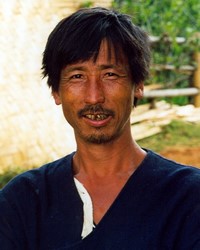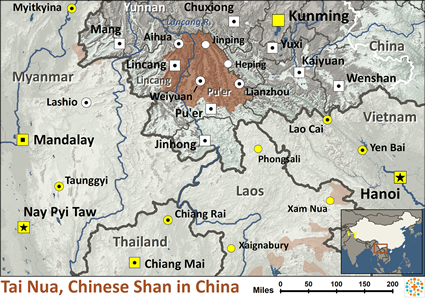Although the Tai Nua are part of the official Dai nationality in China, they speak their own distinct language. They should not be confused with the identically named but different Tai Nua of Laos.
Linguists have pointed out that Tai Nua is "a name given to at least two quite different southwestern branch groups." The Tai Nua profiled here are members of the Southwestern branch of the Tai language family, while the Tai Mao language spoken throughout Dehong Prefecture is similar to the Shan language of Myanmar. The confusion of names is caused partly by "the Chinese tendency to group languages together into nationalities, exemplified by the Dai nationality, which includes all the Southwestern Tai languages of China."
The Tai Nua are historically part of the great Tai peoples of Asia, which dispersed during the past millennia to now inhabit parts of China, Laos, Vietnam, Myanmar, India, and, of course, Thailand. "Based on evidence from Neolithic finds unearthed by archeologists during recent decades it is now believed that before migrating southwards, the forefathers of the present day Thais lived in most parts of Guangxi and Sichuan, plus parts of Guizhou and Yunnan."
After a Tai Nua wedding ceremony the bridegroom goes to live with his bride's family. Traditionally he must take with him gifts of tea, rice, meat, bananas, four eggs, and two salted fish for his new in-laws. Upon arrival, the village elder takes the packets of tea and rice out to the road and calls on the spirits of heaven and earth to witness the marriage. He then ties a white thread seven times around the wrist of the bride and once around the wrist of the groom to indicate their unbreakable commitment to each other.
Buddhists typically have little awareness of their own sin and their need for forgiveness. The Tai Nua do not realize their need for a savior.
Although they are nominally Theravada Buddhists, the Tai Nua have many aspects of animism and polytheism mixed into their beliefs. The very first Tai god was Shalou, the god of hunting. They offered sacrifices to Shalou before a hunt to avert danger and to ensure success.
There are no known Christians among the Tai Nua and very little outreach is presently focused on bringing the gospel to them. Little improvement in their spiritual condition has taken place since the 1920s when one missionary lamented, "There is not a missionary working south of [Kunming] to Mohei, I am here alone, and my little candle is the only light. Yet in these mountains are thousands of tribesmen who have never heard of the gospel."
The Tai Nua people need to put their trust and identity in the hands of the loving God of Creation who sent his son to make it possible for them to enter the Kingdom of God.
Pray for the spiritual blindness and bondage to the evil one to be removed so they can understand and respond to Christ.
Pray for the Lord to provide for their physical and spiritual needs as a testimony of his power and love.
Pray the Tai Nua people will have a spiritual hunger that will open their hearts to the King of kings.
Pray for an unstoppable movement to Christ among them.
Scripture Prayers for the Tai Nua in China.
Operation China, Asia Harvest, Copyrighted © Used with permission
| Profile Source: Joshua Project |


























